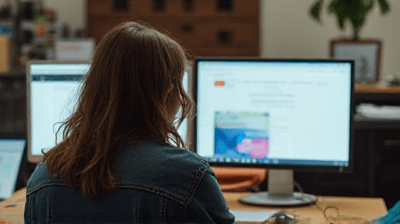In the realm of modern workplaces, open office designs have become quite popular. While this fosters collaboration and communication, it can also lead to an overwhelming amount of noise and distractions. If you have ever tried to concentrate on a task while surrounded by the clamor of ringing phones, animated conversations, and the general hustle and bustle of everyday office life, you are not alone. Many employees struggle with maintaining focus in such an environment.

Understanding the Nature of Distractions
Before diving into solutions, it is essential to understand the types of distractions that commonly occur in an office setting:
1. Auditory Distractions
These distractions include loud conversations, phone calls, laughter, and even the sounds of office equipment like printers or copiers. The human brain is wired to respond to auditory stimuli, so these sounds can easily pull your attention away from your work.
2. Visual Distractions
Visual distractions can occur from movement in your peripheral vision, such as colleagues walking around, screens changing, or even decorative objects in your workspace. These visuals can divert your attention and interrupt your focus.
3. Digital Distractions
In today's digital age, notifications from emails, chat apps, and social media can be significant sources of distraction. The temptation to check your phone or respond to messages can lead to frequent interruptions in your workflow.
4. Environmental Distractions
Environmental factors such as poor lighting, uncomfortable temperatures, and a cluttered workspace can also hinder concentration. A distracting environment can amplify other types of distractions, making it harder to focus on tasks.
The Psychological Impact of Distractions
Distractions in the workplace can have various psychological effects, including:
- Increased Stress: Constant interruptions can lead to feelings of anxiety and frustration.
- Decreased Productivity: Studies show that it can take several minutes to regain focus after being distracted.
- Reduced Job Satisfaction: An inability to complete tasks efficiently can lead to feelings of inadequacy and unhappiness at work.
Strategies to Minimize Distractions
Now that we have an understanding of distractions and their impacts, let’s discuss several strategies to help you minimize interruptions and maintain focus in a noisy office.
1. Create a Personal Focus Plan
Having a plan can significantly boost your ability to concentrate. Consider the following steps:
- Prioritize Your Tasks: Start each day by identifying your most important tasks. Use a planner or digital tools to jot down your goals for the day.
- Time Blocking: Allocate specific blocks of time to work on different tasks. Dedicate uninterrupted time slots during which you turn off notifications and only focus on one task at a time.

2. Use Noise-Cancellation Tools
Investing in noise-canceling headphones can be a game changer in a loud environment. These headphones can help block out external noise, allowing you to concentrate better on your work. Here are some types to consider:
- Active Noise-Canceling Headphones: These use technology to reduce background noise.
- Comfortable Earplugs: If headphones are impractical, consider using earplugs for a quieter environment.
3. Find Your Ideal Workspace
If possible, choose a workspace that minimizes distractions. Consider the following options:
- Quiet Zones: Many offices have designated quiet areas or rooms where employees can work without noise.
- Screen Positioning: Set up your workspace to reduce visual distractions, like positioning your screen against a wall or away from high-traffic areas.
4. Control Your Digital Environment
Managing digital distractions is crucial for maintaining focus. Here are some tips:
- Turn Off Notifications: Silence notifications for email, social media, and chat apps while you work.
- Set Boundaries: Communicate with colleagues about your focus time. A simple “do not disturb” sign can signal that you are in a concentration mode.
5. Practice Mindfulness Techniques
Practicing mindfulness can greatly enhance your ability to focus. Some techniques include:
- Meditation: Spend a few minutes each day meditating to improve your concentration levels.
- Deep Breathing: Take a moment to breathe deeply when feeling overwhelmed. This can help center your thoughts and clear your mind.
6. Take Regular Breaks
Taking breaks is essential for maintaining your focus and preventing burnout. Here’s how to do it effectively:
- The Pomodoro Technique: Work for 25 minutes and then take a 5-minute break. After four cycles, take a longer break (15-30 minutes).
- Get Moving: Use your breaks to stand up, stretch, or walk around. Physical movement can rejuvenate your mind and body.
7. Manage Your Workspace
A clean and organized workspace can significantly reduce distractions. Implement these practices:
- Declutter Regularly: Keep your desk tidy by removing unnecessary items, which can help minimize visual distractions.
- Use Tools Wisely: Utilize organizational tools like desk organizers or digital project management software to keep your tasks in order.
8. Communicate with Colleagues
Fostering a culture of respect for focus time within your workplace can help reduce distractions. Consider the following approaches:
- Set Expectations: Communicate your working style with your colleagues. Let them know when you will be available for discussions versus when you need to focus.
- Collaborative Tools: Use shared calendars or project management tools to coordinate meeting times and deadlines.
9. Personalize Your Environment
Making your workspace more comfortable can help maintain focus. Consider:
- Personal Touches: Add items that inspire you, like photos or motivational quotes, as long as they don’t create further distractions.
- Lighting: Ensure your workspace is well-lit without being harsh. Natural light can uplift mood and concentration levels.
Conclusion
Staying focused in a noisy office is a challenge faced by many employees. However, by implementing these strategies, you can effectively minimize distractions and enhance your productivity. Remember that it’s important to find what works best for you, as each person’s focus strategies may differ.
In a world where distractions are plentiful, taking control of your work environment is key to achieving your goals. Focus on creating a personal productivity plan, utilizing noise-cancellation tools, maintaining an organized workspace, and communicating effectively with your colleagues. By doing so, you not only improve your own work experience but also contribute to a culture of respect for concentration in the office.



